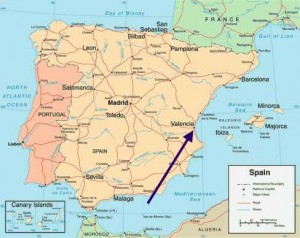PAELLA
Origins of Paella
 The Paella is of Arabic provenience and humble beginnings indeed. It originated in the region of Valencia in Eastern Spain. Valencia is one of the largest ports by the Mediterranean Sea and is a rice producer in Spain since it was introduced by the Arabs or Moors over 1200 years ago. The word for “rice” in Spanish is “Arroz” which is derived from the Arabic “Arruzz”.
The Paella is of Arabic provenience and humble beginnings indeed. It originated in the region of Valencia in Eastern Spain. Valencia is one of the largest ports by the Mediterranean Sea and is a rice producer in Spain since it was introduced by the Arabs or Moors over 1200 years ago. The word for “rice” in Spanish is “Arroz” which is derived from the Arabic “Arruzz”.
Paella was originally the meal of peasants, cooked over an open wood fire in the rice fields and eaten by the peasants directly from the pan with their own wooden spoons. It was originally made of rice and whatever ingredient was readily at hand, usually tomatoes, onions, leeks and snails, with some green beans and garbanzos for texture. Duck or rabbit were also added if available and for special occasions chicken and a touch of saffron for color and added flavor.
There are as many variations of Paellas as there are cooks. As the region of Valencia is located by the coastal waters, over the generations, seafood ostensibly crept into the recipes. La Paella is today the collective name of some unknown number of distinctive rice dishes from that region and other parts of Spain, and the world. The “true” Paella Valenciana to this day contains no seafood, but a choice of chicken, duck, or rabbit; and snails, green beans and garbanzos.
In Spain, making La Paella is usually left to the men; much like BBQ is left to the men in the U.S.
La Paella is the most sociable of all culinary occasions. In Spain, La Paella is still unique. Not only do families congregate to eat Paella in restaurants, but it is often cooked on weekends in ‘bodegas’ or ‘txokos’, which are large dining areas where families gather; or at beach or mountain picnic sites. Very often, gigantic Paellas are centerpieces for many parties.
TAPAS
Origins of Tapas
Tapa is a Spanish word that means “cover” or “lid”.
The story goes that King Alfonso X, byname “Alfonso the Wise” or “The Learned,” in Spanish “Alfonso El Sabio,” King of Castilla and Leon from 1252 to 1284. While on a long trip, the King stopped to rest at a hostel in the town of Ventorillo del Chato in the Southern province of Cádiz and ordered a glass of Jerez (Sherry) to sit and relax after the long journey.
There was a gusty wind and lots of sand dust flying all over the place, so the Inn-keeper served him his glass of Jerez covered with a slice of ham to prevent the sand from getting into the drink. King Alfonso X ate the ham and chased it with his Jerez, and liked it. He then asked for a second glass of Jerez and requested that it comes with a “tapa” or lid.
